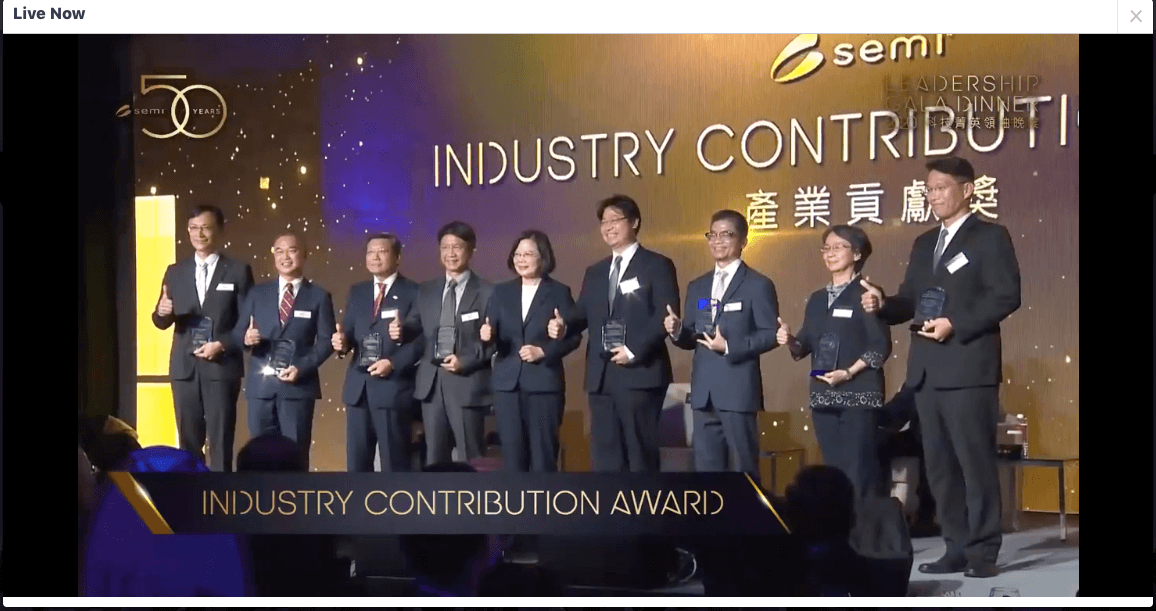It’s funny. While COVID 19 has restricted our lives in many ways, in others it’s made things more possible. Take SEMICON Taiwan – an event I have yet to attend in person. Because of COVID, this year there is a hybrid version that makes it possible for all to participate, wherever you are. You can even fit it into a busy schedule. I wasn’t able to attend online last week, but this week, I have time. Sure, I missed out on the live streaming events – (I’m not so committed that I want to get up at 3 am AZ time). But there’s tons of great content on demand.
SEMI has definitely upped its virtual game with this event. Literally. The hybrid SEMICON Taiwan platform feels much more like virtual reality than SEMICON West. And I don’t have VR glasses. I spent a day wandering the “halls” and catching some of the presentations. I also stopped by the networking lounge to see how it works. Still text chat – and not much happening there, but maybe it was different last week?
Here are the highlights of my visit. If you want a deeper dive, it’s not too late to register and check it out for yourself.
SEMICON Taiwan Virtual Exhibit Hall
This was fun. It seems inspirational videos are the key to the virtual booths at SEMICON Taiwan. I stopped by 3D InCites Community Member booths to check out their video.
- ASE’s booth provided a great explanation of its FoCoS technology – emphasizing that it is for homogeneous – not heterogeneous integration.
- KLA’s video focused on the really cool end-user applications do demonstrate its Keep Looking Ahead philosophy.
- Lam Research’s video focused on its 40 years of enabling the industry.
I expected more than 50ish virtual booths – but I guess most exhibitors took advantage of the live exhibits when possible.
SEMI Market Forecast
I caught Clark Tseng’s SEMICON Taiwan market update. He warns that the headwinds in 2020 may continue into 2021. The world GDP has declined 5% and has had a negative impact across most end markets, except for data centers and PCs. (We can thank COVID for growth there, with the shift to working from home and video conferencing). In fact, COVID has accelerated the digital transformation of businesses worldwide. The smartphone and automotive markets suffered most, he said. While we can continue to expect demand to improve, a resurgent of cases may send us all back into partial closure, which will impact the pace of recovery.
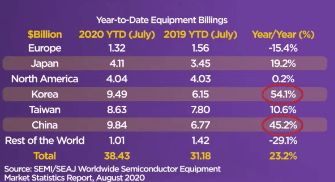
Table 1: Year-to-date equipment billings indicates CAPEX growth in Asia is surpassing in other regions. (Courtesy of SEMI)
But far more damaging to the semiconductor supply chain than COVID 19 is the geopolitical tension between the US and China, noted Tseng. While the US trade restrictions on China and particularly Huawei (and I imagine now SMIC) have created uncertainty in the supply chain. However, Tseng says he thinks the impact will be short term and will normalize in the coming quarters. He expects the pace for local Chinese infrastructure to accelerate considerably as a result, and he predicted that post-COVID 19, China and the rest of Asia could wind up leading the economic recovery (Table 1).
Master Forum
Not all the keynotes are available from the live master forum. But I watched three – Tim Archer, CEO of Lam Research, Jean-Marc Chery, CEO, ST Microelectronics, and Manish Bhatia, SVP at Micron, and there were some common threads throughout. Everyone, of course, addressed
the impact of COVID on the industry, not about market impact, but how it’s changed our way of thinking and our use of technology to solve its challenges. AI and 5G are seen as enabling technologies, and as such are driving growth in the semiconductor industry.
Archer mentioned the important milestones of SEMI’s 50th anniversary and Lam Research’s 40th year since founding. He talked of notable change – the continued globalization of semiconductor development and manufacturing, and how Taiwan plays a leading role in this. In the 1980s, Taiwan represented a mere 1% of the world’s semiconductor revenues. Today that has grown to 23%, he said. Moreover, he said, this supports the geographical shift. He said Lam is adding sites in Asia to increase its local presence.
We must prepare for a dynamic future, noted Archer, in which technology provides the answers to our challenges – referring to COVID. “We could not have foreseen that webcams would become an essential school supply a year ago. Technology is helping us find our way through this pandemic.”
Specifically, Archer detailed growth in video conferencing being beyond what anyone could have forecasted. Microsoft Teams reports over 5B meeting minutes a day, Zoom has gone from 10M users a day to over 300M users a day in less than a year. PlayStation 4 games sales have doubled, and Netflix subscribers have increased to 193M.
He said these new generations mean more complexity, process steps, and materials, which generally take longer development times and greater use of resources. Delivering next-generation technology in the midst of a pandemic requires disruptive solutions that bridge the virtual and physical realms.
At Lam, where they’ve continued to maintain pre-COVID productivity, he said they’ve managed to overcome travel restrictions and in-person interactions by removing the need for physical proximity to achieve success. For example, using computational models, machine learning and data mining, Lam’s process engineers can now simulate process development without needing to be inside the cleanroom. Figure 1 shows more examples of how Lam is using both virtual and augmented reality for everything from training centers to remote support for tool installation.
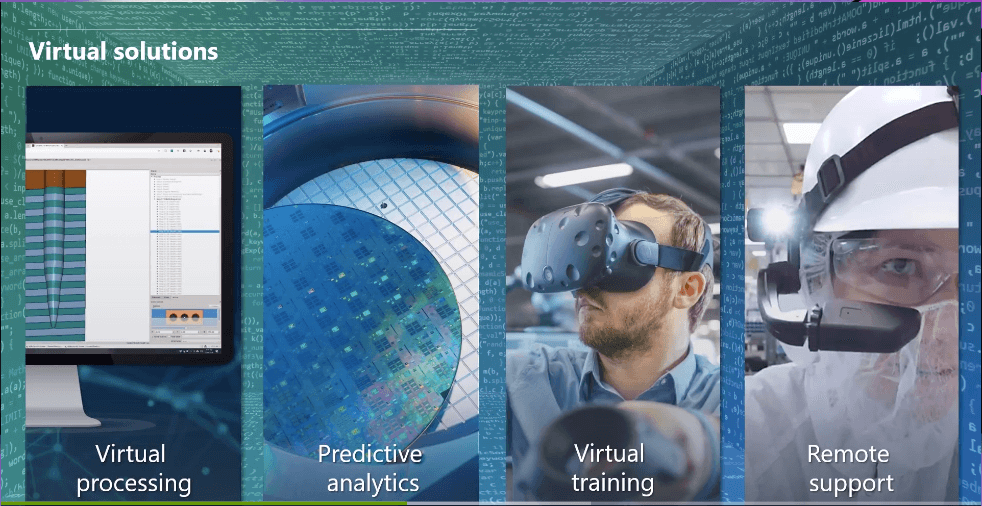
Jean-Marc Chery added smart mobility, power energy management, and the Internet of Things to the industry trends driving growth. He detailed efforts at ST to help make driving safer and greener, increase energy efficiency everywhere, and provide sensors plus all their trappings to make device and system development fast and easy.
Bhatia focused on 5G and AI as engines for growth from the perspective of memory and storage. He also gave a shout out to Taiwan, for its success in managing COVID. The country has seen the least impact from the pandemic.
According to Bhatia, DRAM and NAND now represent 25-30% of the SEMI market and is growing faster than the rest of the industry, driven by the needs of AI and 5G, which complement each other in all applications, especially cloud, automotive, mobile, networking, and IoT. These new engines are powering the 4th industrial revolution.
Bhatia said we will the industry will infuse $11.4 Trillion into the global economy by 2035. This new wave of innovation will transform multiple industries over the next decade, including mobility, healthcare, media and entertainment, agriculture, and industrial, the common thread across them all is the vast oceans of data they will generate (Figure 2).
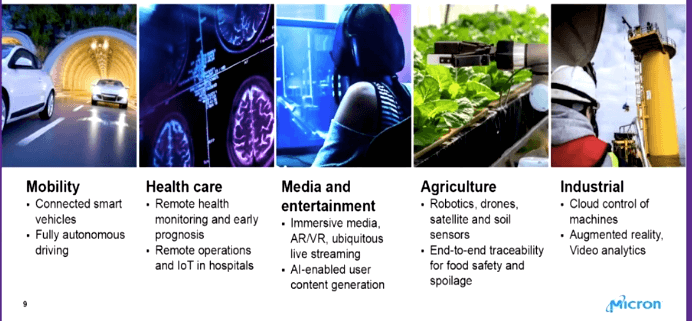
He took a deep dive into each industry segment to explain how and why this will happen:
- The ultra-low latency and connectivity of 5G enable autonomous vehicles, and we can expect to see fully autonomous cars on the roads by 2030. This was the first time in a couple of years I’ve heard someone tout the benefits of full autonomy, and I have to say it felt strange. I thought ADAS was the focus now.
- On the topic of healthcare, his pitch was for telemedicine, and how 5G and AI allow doctors to see more patients in lest time. It will also reduce the time patients spend in hospitals and will reduce medical bills. (I’ll let you know what I think of virtual office visits after my next appointment, which has been reduced to 15 minutes but will still cost $50 copay.) He also said AI will bring breakthroughs in curing serious illnesses and will increase life expectancy worldwide from 74 to 84 in 5-10 years.
- 5G and AI are expected to generate 1.3 Trillion in revenue int the media and entertainment industry by 2030 with elements like real-time immersive experiences. Everyone will become a content creator. with AI-enabled editing and visual storytelling. (I guess I’ll be out of a job.)
- Monthly traffic per 5G subscriber will increase 7x by 2030.
- There will be new ways of learning, such as visual learning and mixed reality group learning. (Why even bother to learn how to read?)
- We’ll be able to feed the world by increasing the efficiency of agriculture, increasing yield and improving the quality of products.
- We can unlock hidden potential in the manufacturing infrastructure and productivity by cloud control of machines, using industrial data at scale, and using VR.
Ok, that’s enough of that. Let’s move on.
Heterogeneous Integration Zone
A quick tour of the Heterogeneous Integration Innovation Zone by host Ashley Cho offered a glimpse of what’s being talked about there.
Teck Lee, ASE, talked about the companies’ FoCoS solution that allows for the integration of ASICS from two to more than 10 into a single package. He said ASE’s solutions, including C4, redistribution layers (RDL), and Cu pillar, will be available to all high-performance computing (HPC) customers.
Nicky Lu, of Eton, said the company believes HI will take us another 20-30 years ahead on the roadmap. From today’s HI that involves integrating DRAM, SoCs, and chips from Etron to create a microsystem, for example, to future advancements. Photonics is one to watch, he noted.
PPACC is TSMC’s favorite new acronym. We’ve heard Doug Yu talk about it. In this video, Dr. Kuo-Chung Yee, director of R&D spelled it out for us: “The first ‘P’ is power efficiency. The second ‘P’ is the system performance, ‘A’ is the area form factor, first ‘C’ is the cost of ownership. The Last ‘C’ is fast time to market,” he said. (I’m trying to figure out what begins with “C” in time to market, but whatever).
SEMICON Taiwan Leadership Gala Dinner
I’m not one to miss a Gala Dinner, even a virtual one. But the timing was off to attend live. Luckily, the SEMICON Taiwan Leadership Gala Dinner was available On Demand. So, I ordered some take-out, poured a glass of wine, and settled in to enjoy the show. I felt a bit like a fly on the wall, watching everyone gather, wearing masks, of course. Taiwan knows how to throw a party. And SEMI finally had its 50th-anniversary celebration. Most Gala’s I’ve been to, people are wearing whatever business attire they were decked out in during the day. But here, we’ve got glitz and glamour.
Among the honored guests were many government dignitaries. Speakers included Ajit Manocha, who welcomed everyone via a pre-recorded speech. He thanked Taiwan’s president, Dr. Ing-wen Tsai, for her participation over the years, acknowledged ASE’s Tien Wu, who will lead this year’s delegation to will meet with Dr. Tsai; Mark Liu, chairman of TSMC, spoke of Taiwan’s commitment to becoming a critical force in the global economy.
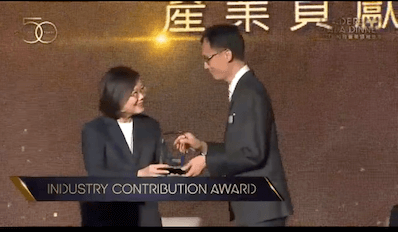
Dr. Tsai’s speech was the highlight of the evening. She described the efforts her team makes to make Taiwan a better place for investors and industrialists. Through collaboration between the private sector and the government, Taiwan’s semiconductor industry is an important part of Taiwan’s contribution to the world, she said. While the global semiconductor industry output expected to decline 2.4% in 2020, she said Taiwan’s domestic industry set to grow 12.6% with a record annual output of 100B USD. Taiwan is positioning itself to be a global hub for the growing digital economy.
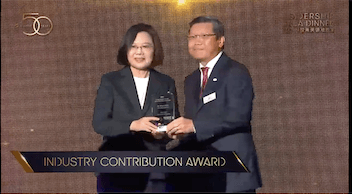
Dr. Tsai also presented SEMI’s Industry Contribution Awards. While most of the awards went to TSMC team members, I was pleased to see some of our community members among the recipients, including Jimmy Chen, Quality Assurance at ASE (Figure 3), and Rutgers Chow, EVP of worldwide sales at SPTS (Figure 4). Congratulations and well done!
That pretty much wraps up my adventures Virtual SEMICON Taiwan, except for the SiP Global Summit, which is worth its own post. I urge you all to check it out. ~ FvT




